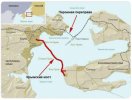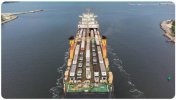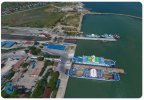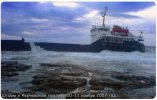Install the app
How to install the app on iOS
Follow along with the video below to see how to install our site as a web app on your home screen.
Note: This feature may not be available in some browsers.
You are using an out of date browser. It may not display this or other websites correctly.
You should upgrade or use an alternative browser.
You should upgrade or use an alternative browser.
Ukrainan konflikti/sota
Katsoin klipin, pakko myöntää että aika osuvaa puhetta oli, tuo loppu tosin oli melkoisen lennokasta fantasiointia.Nyt kun sotaa kulunut jo 8kk, niin kaivoin tämän Nevzovin viimevuonna (loppukesä/syksy 2021) tekemän ennustuksen uudestaan esille. Ihmettelin jo sodan ensimmäisinä kuukausina kuinka tarkasti ukko osoitti miten sota tulee valumaan. Ainoa jota ei täysin onnistunut ennustamaan oli, että mobilisaatio tapahtui näinkin myöhään. Edellisen kerran taisin tätä ennustusta katsella kun Japanista alkoi kuulua ääniä Kurillien saarien suhteen.
Liikaa ukko saanut napakymppiosumia ja mitä pitemmälle vetää, niin sitä tarkemmalta vaikuttaa. Tosin, sanamuodoille voi antaa tästä sen millimetrin krediittiä koska ukko puhuu ns. runollista venäjää (paljon kielikuvia), mutta kuitenkin... Kenties loppuennustus kuulostaa liian hurjalta, mutta kattoo miten tilanne etenee.
Ukon muu contentti on suhteellisesti myös laadukasta, vaikka vähemmän yllättäen hyvin puolueellista. Tekstityskäännökset muihin videoihin kyllä saa RU->ENG, mutta koska ukon puhuma kieli on niin metaforista, niin videoista ei ikävä kyllä saa paljoa irti muut kuin natiivit venäjänpuhujat.
Pahoittelut repostauksesta, mutta mielestäni hyvä palauttaa muistiin.
Itselläni vieläkin hieman "mind blown" olo.
RKSTAK
Ylipäällikkö
Uutta tietoa taas iskuista Kiovaan.
Vähän ku 10 tikkua laudalla, että kranun jälkeen kaikki pois piiloista. Edellisen kranaatin kuoppa on aivan aliarvostettu jemma. Ei se tuu samaan kohtaan kahta kertaa koskaan noin harvassa pommituksessa.Jaa puita!
AMC
Ylipäällikkö
Isoalaviiva
Eversti
Osuko toi paskahuussiin ja ukko lensi sieltä vai kuvittelinko vaan?
Lievästi OT, mutta...
Silmät auki sen osalta kuuluisiko lähiaikoina uutisia siitä, että Iranissakin alettaisiin tupakoimaan.

Shahed-136 tehdas/kokoamishalli spotattu Iranissa Isfahanin provinssissa.
Silmät auki sen osalta kuuluisiko lähiaikoina uutisia siitä, että Iranissakin alettaisiin tupakoimaan.

Shahed-136 tehdas/kokoamishalli spotattu Iranissa Isfahanin provinssissa.
Osuko toi paskahuussiin ja ukko lensi sieltä vai kuvittelinko vaan?
Ikävä kohtalo harvinaiselle siististi paskovalle vanjalle?
Taitaa olla heittoistumet jotka peräjälkeen laukeavat tuossa. Hetkeä ennen törmäystä kerrostaloon.Video törmäyksestä kun kone vielä ilmassa.
saftamil
Kenraali
Surovikin twiittailee. Tässä google käännös lontooksi:
I no longer want to sacrifice Russian soldiers in the guerrilla war against hordes of fanatics armed with NATO to no avail. We have enough strength and technical means to lead Ukraine to complete surrender.
I no longer want to sacrifice Russian soldiers in the guerrilla war against hordes of fanatics armed with NATO to no avail. We have enough strength and technical means to lead Ukraine to complete surrender.
teknohippi
Ylipäällikkö
Ei ole paskahuussi kun ryssät ei käytä. Paskovat majoitustilan lattialle.Osuko toi paskahuussiin ja ukko lensi sieltä vai kuvittelinko vaan?
Oi... Mitäs hemskattia...
Missään lähellä venäjän tai valkovenäjän rajaa ei näy enää sotilaslentokoneita....
(viron päällä olevat belgialaiset f-16:t poikkeus)

Käsittääkseni NATOlla on harkat menossa, mutta ei missään tuolla päin vaan NATOn oman tiedotteen mukaan "pohjois-länsi-suunnassa" eli brittilän ja norskilan välissä...
En nyt keksi miksi kaikki koneet ovat ponderit pois päältä koko itäeuroopassa viroa lukuunottamatta.
Missään lähellä venäjän tai valkovenäjän rajaa ei näy enää sotilaslentokoneita....
(viron päällä olevat belgialaiset f-16:t poikkeus)

Käsittääkseni NATOlla on harkat menossa, mutta ei missään tuolla päin vaan NATOn oman tiedotteen mukaan "pohjois-länsi-suunnassa" eli brittilän ja norskilan välissä...
En nyt keksi miksi kaikki koneet ovat ponderit pois päältä koko itäeuroopassa viroa lukuunottamatta.
Antares
Respected Leader
Lyhyt ketju Kerchin sillan vieressä kulkevista lautoista. Nämä tosiaan eivät voi kulkea liian kovan tuulen aikaan ja ovat parhaillaankin pois käytöstä:
Tuossa oli itseasiassa niin paljon hyvää asiaa Kerchin sillan vieressä liikkuvista lautoista että poimin sen tähän spoilerin taakse.
Vastaa moneen minuakin vaivanneeseen kysymykseen eli mikä määrä rahtia Krimille kuljetettiin ennen sen valtaamista, mitä tapahtui valtaamisen jälkeen, mitkä asiat vaikeuttavat rahdin kuljettamista lautoilla ja miten tuleva talvi voi vaikuttaa sillan korjaamisen aikatauluun: LÄHDE
Recent news that ferries across the Kerch Strait couldn't run because of high winds highlights a major problem for Russia: the disabling of the Kerch Bridge to Crimea has happened at a very bad meteorological moment. Thread follows.
Prior to the construction of the Kerch Bridge, ferries used to run across the narrowest point of the strait, where it's less than 5km wide, between Port Krym (west) and Port Kavkaz (east). This is about 12km northeast of the bridge. Ferries also ran to Novorossiysk.

From 2014 when Russia annexed Crimea to 2018, the peninsula's landward side was effectively blockaded by Ukraine, which closed the crossings linking it to the Ukrainian mainland. This left it almost entirely dependent on the ferries, which were overwhelmed by demand.
In the summer of 2014, up to 1,400 cars at a time waited in line for as long as 27 hours to cross the strait. Traffic increased even more over the next two years. In 2015, the ferries carried 4.7 million passengers, 1,070,000 cars, 250,000 trucks and 77,000 wagons.
In 2016 the figure grew even more to 6,248,000 people, 1,289,000 cars, 296,000 units of freight transport and 50,900 buses. The crossing briefly became the busiest in the world in terms of traffic. This all switched to the Kerch Bridge when it opened and the ferries shut down.

Before the annexation, an estimated two-thirds of food and consumer goods, and virtually all refined oil products and coal used in Crimea were imported from mainland Ukraine. This all had to switch over to the ferries, and subsequently the bridge.
The quantities involved are very large. In the winter of 2014, 32,000 tons of coal had to be shipped in to supply the government and public sector. Another 30,000 tons were needed to supply the quarter of Crimean households not connected to the regional gas grid.
This required a fleet of vehicle and train ferries making up to 115 daily crossings. Some ferries have been brought back into use to replace the bridge, but the old ferry fleet no longer exists (though the ports are still there). So there is an obvious capacity problem.

But there's another issue that the video above highlights: winter weather. This is a very serious problem, not only for the ferry but also for the workers repairing the bridge. This work isn't due to be completed until July 2023. Why so long?
Weather is likely to be a major factor. The Kerch Strait can be extremely windy. The wind's effects can be seen in the billowing smoke, flames and choppy water visible in this video of the fuel train fire on the bridge on 8 October.
The average annual wind velocity ranges from 4 to 8 m/sec (14 to 29 km/h). The north-east and east winds often reach speeds of 28 m/sec (101 km/h) with the highest continuous speed recorded being more than 40 m/sec (144 km/h). Wind gusts can reach far higher speeds.
Storms are frequent in the cold season, which runs from November to April. This causes serious dangers for shipping. On 11-12 November 2007, four ships sank in the strait during a storm which produced wind speeds of over 115 km/h and wave heights of 4m.

According to the Crimean authorities, large ferries cannot operate at wind speeds of 17 m/sec or higher, while smaller ferries cannot operate at 12 m/sec. At this time of year, statistically at least 9 days a month see a wind speed of more than 15 m/sec.
This can effectively cut Crimea off from Russia for days at a time, causing huge backlogs on both sides of the strait and producing shortages of goods and supplies in Crimea.
Fog creates further problems for shipping in the strait during the cold season. It occurs on average 35-45 times per year, lasting up to 19 hours, mostly occurring at night and in the morning.

Ice is also a major problem. A Soviet attempt to build a bridge across the Kerch Strait in the 1940s fell victim to ice floes, which knocked over several of the spans and forced the Soviets to demolish it as a navigation hazard.
The ice comes from the Sea of Azov, which is one of the least saline seas in the world. It begins to form in November and reaches the Kerch Strait by the end of December.
Ice floes drifting down from the Sea of Azov tend to be about 1-2m thick. In severe winters, the Kerch Strait is covered with solid immovable ice of about 0.70 m thickness. It lasts until around March.
This is very disruptive for shipping. In February 2017, for instance, severe icing caused major problems for the ferries and effectively cut off access to Crimea. More than 1,000 trucks queued for up to 80 hours to cross the strait via the ferries.
During such conditions, icebreakers are used to keep the strait navigable. It should be noted that snow and ice can also close the bridge from time to time.
All of these weather issues reduce ferry capacity still further. Although there has been a lot of emphasis on the number of ferries available, weather conditions this winter will be at least as big a factor in keeping Crimea supplied.
It will also significantly affect the bridge repair work. The damaged spans, and possibly the supporting pillars, will need to be replaced. It will certainly take at least weeks to manufacture replacements, by which time we'll be well into winter.
The replacement spans will need to be brought on barges to the site. As this video illustrates, access to the water is essential for the repair works. That's going to be much harder when winter arrives fully and the sea freezes.
Linkki viestiin jossa on tämä viitattu video
So this likely helps to explain the lengthy July 2023 deadline. Even if the Russians can manufacture the new spans before Christmas, they likely wouldn't be able to install them before the spring at the earliest.
Russia will certainly try to get the railway bridge back into use as quickly as possible, but the damage resulting from the fuel fire is likely to have affected the number and weight of trains that can safely cross.
As a result, it's safe to conclude that conditions in Crimea are likely to be difficult, goods scarce and prices high this winter. The Crimeans will have to hope for a mild winter. /end
Prior to the construction of the Kerch Bridge, ferries used to run across the narrowest point of the strait, where it's less than 5km wide, between Port Krym (west) and Port Kavkaz (east). This is about 12km northeast of the bridge. Ferries also ran to Novorossiysk.

From 2014 when Russia annexed Crimea to 2018, the peninsula's landward side was effectively blockaded by Ukraine, which closed the crossings linking it to the Ukrainian mainland. This left it almost entirely dependent on the ferries, which were overwhelmed by demand.
In the summer of 2014, up to 1,400 cars at a time waited in line for as long as 27 hours to cross the strait. Traffic increased even more over the next two years. In 2015, the ferries carried 4.7 million passengers, 1,070,000 cars, 250,000 trucks and 77,000 wagons.
In 2016 the figure grew even more to 6,248,000 people, 1,289,000 cars, 296,000 units of freight transport and 50,900 buses. The crossing briefly became the busiest in the world in terms of traffic. This all switched to the Kerch Bridge when it opened and the ferries shut down.

Before the annexation, an estimated two-thirds of food and consumer goods, and virtually all refined oil products and coal used in Crimea were imported from mainland Ukraine. This all had to switch over to the ferries, and subsequently the bridge.
The quantities involved are very large. In the winter of 2014, 32,000 tons of coal had to be shipped in to supply the government and public sector. Another 30,000 tons were needed to supply the quarter of Crimean households not connected to the regional gas grid.
This required a fleet of vehicle and train ferries making up to 115 daily crossings. Some ferries have been brought back into use to replace the bridge, but the old ferry fleet no longer exists (though the ports are still there). So there is an obvious capacity problem.

But there's another issue that the video above highlights: winter weather. This is a very serious problem, not only for the ferry but also for the workers repairing the bridge. This work isn't due to be completed until July 2023. Why so long?
Weather is likely to be a major factor. The Kerch Strait can be extremely windy. The wind's effects can be seen in the billowing smoke, flames and choppy water visible in this video of the fuel train fire on the bridge on 8 October.
The average annual wind velocity ranges from 4 to 8 m/sec (14 to 29 km/h). The north-east and east winds often reach speeds of 28 m/sec (101 km/h) with the highest continuous speed recorded being more than 40 m/sec (144 km/h). Wind gusts can reach far higher speeds.
Storms are frequent in the cold season, which runs from November to April. This causes serious dangers for shipping. On 11-12 November 2007, four ships sank in the strait during a storm which produced wind speeds of over 115 km/h and wave heights of 4m.

According to the Crimean authorities, large ferries cannot operate at wind speeds of 17 m/sec or higher, while smaller ferries cannot operate at 12 m/sec. At this time of year, statistically at least 9 days a month see a wind speed of more than 15 m/sec.
This can effectively cut Crimea off from Russia for days at a time, causing huge backlogs on both sides of the strait and producing shortages of goods and supplies in Crimea.
Fog creates further problems for shipping in the strait during the cold season. It occurs on average 35-45 times per year, lasting up to 19 hours, mostly occurring at night and in the morning.

Ice is also a major problem. A Soviet attempt to build a bridge across the Kerch Strait in the 1940s fell victim to ice floes, which knocked over several of the spans and forced the Soviets to demolish it as a navigation hazard.
The ice comes from the Sea of Azov, which is one of the least saline seas in the world. It begins to form in November and reaches the Kerch Strait by the end of December.
Ice floes drifting down from the Sea of Azov tend to be about 1-2m thick. In severe winters, the Kerch Strait is covered with solid immovable ice of about 0.70 m thickness. It lasts until around March.
This is very disruptive for shipping. In February 2017, for instance, severe icing caused major problems for the ferries and effectively cut off access to Crimea. More than 1,000 trucks queued for up to 80 hours to cross the strait via the ferries.
During such conditions, icebreakers are used to keep the strait navigable. It should be noted that snow and ice can also close the bridge from time to time.
All of these weather issues reduce ferry capacity still further. Although there has been a lot of emphasis on the number of ferries available, weather conditions this winter will be at least as big a factor in keeping Crimea supplied.
It will also significantly affect the bridge repair work. The damaged spans, and possibly the supporting pillars, will need to be replaced. It will certainly take at least weeks to manufacture replacements, by which time we'll be well into winter.
The replacement spans will need to be brought on barges to the site. As this video illustrates, access to the water is essential for the repair works. That's going to be much harder when winter arrives fully and the sea freezes.
Linkki viestiin jossa on tämä viitattu video
So this likely helps to explain the lengthy July 2023 deadline. Even if the Russians can manufacture the new spans before Christmas, they likely wouldn't be able to install them before the spring at the earliest.
Russia will certainly try to get the railway bridge back into use as quickly as possible, but the damage resulting from the fuel fire is likely to have affected the number and weight of trains that can safely cross.
As a result, it's safe to conclude that conditions in Crimea are likely to be difficult, goods scarce and prices high this winter. The Crimeans will have to hope for a mild winter. /end
Viimeksi muokattu:
AMC
Ylipäällikkö
saftamil
Kenraali
Tässä toinen piloteista. Taustalla kuuluu kun koneen ammukset räjähtelee. Konehan oli virallisesti harjoituslennolla.
AMC
Ylipäällikkö
Pari murkulaa jätetty palautettavaksi.




